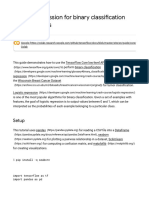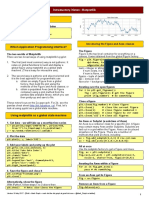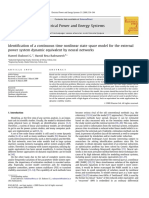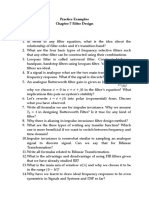Better Data Science - Make Synthetic Datasets With Python
Uploaded by
Derek DegbedzuiBetter Data Science - Make Synthetic Datasets With Python
Uploaded by
Derek DegbedzuiBetter Data Science | Make Synthetic Datasets
with Python
● Library imports
● rcParams is only here for plot stylings
In [1]:
import numpy as np
import pandas as pd
from sklearn.datasets import make_classification
import matplotlib.pyplot as plt
from matplotlib import rcParams
rcParams['axes.spines.top'] = False
rcParams['axes.spines.right'] = False
Make a synthetic dataset
● 1000 data points measured through 2 features
● Perfect (50:50) class distribution
● Binary target variable, every subset has a single cluster
● Make sure to use random_state=42 if you want reproducible results
In [2]:
X, y = make_classification(
n_samples=1000,
n_features=2,
n_redundant=0,
n_clusters_per_class=1,
random_state=42
)
df = pd.concat([pd.DataFrame(X), pd.Series(y)], axis=1)
df.columns = ['x1', 'x2', 'y']
# 5 random rows
df.sample(5)
Visualization
● The plot() function visualizes a synthetic dataset:
In [3]:
def plot(df: pd.DataFrame, x1: str, x2: str, y: str, title: str = '', save: bool = False,
figname='figure.png'):
plt.figure(figsize=(14, 7))
plt.scatter(x=df[df[y] == 0][x1], y=df[df[y] == 0][x2], label='y = 0')
plt.scatter(x=df[df[y] == 1][x1], y=df[df[y] == 1][x2], label='y = 1')
plt.title(title, fontsize=20)
plt.legend()
if save:
plt.savefig(figname, dpi=300, bbox_inches='tight', pad_inches=0)
plt.show()
In [4]:
plot(df=df, x1='x1', x2='x2', y='y', title='Dataset with 2 classes')
Adding noise
● You can use the flip_y parameter to add noise
● From the docs:
○ The fraction of samples whose class is assigned randomly. Larger
values introduce noise in the labels and make the classification
task harder. Note that the default setting flip_y > 0 might lead to
less than n_classes in y in some cases.
In [5]:
X, y = make_classification(
n_samples=1000,
n_features=2,
n_redundant=0,
n_clusters_per_class=1,
flip_y=0.15,
random_state=42
)
df = pd.concat([pd.DataFrame(X), pd.Series(y)], axis=1)
df.columns = ['x1', 'x2', 'y']
plot(df=df, x1='x1', x2='x2', y='y', title='Dataset with 2 classes - Added noise')
Add class imbalance
● Perfect class distribution (50:50) is rarely the case
● You can use the weights parameter to play with the distribution
○ Assigning the value of 0.95 makes the y = 1 class take 5% of the
data
In [6]:
X, y = make_classification(
n_samples=1000,
n_features=2,
n_redundant=0,
n_clusters_per_class=1,
weights=[0.95],
random_state=42
)
df = pd.concat([pd.DataFrame(X), pd.Series(y)], axis=1)
df.columns = ['x1', 'x2', 'y']
plot(df=df, x1='x1', x2='x2', y='y', title='Dataset with 2 classes - Class imbalance (y = 1)')
● You can do the opposite:
In [7]:
X, y = make_classification(
n_samples=1000,
n_features=2,
n_redundant=0,
n_clusters_per_class=1,
weights=[0.05],
random_state=42
)
df = pd.concat([pd.DataFrame(X), pd.Series(y)], axis=1)
df.columns = ['x1', 'x2', 'y']
plot(df=df, x1='x1', x2='x2', y='y', title='Dataset with 2 classes - Class imbalance (y = 0)')
Make classification task easier/harder
● You can play around with the class_sep parameter to adjust class separation
● Higher the value, the more separated the classes are
In [8]:
X, y = make_classification(
n_samples=1000,
n_features=2,
n_redundant=0,
n_clusters_per_class=1,
class_sep=5,
random_state=42
)
df = pd.concat([pd.DataFrame(X), pd.Series(y)], axis=1)
df.columns = ['x1', 'x2', 'y']
plot(df=df, x1='x1', x2='x2', y='y', title='Dataset with 2 classes - Make classification easier')
You might also like
- AIML%20Short%20Term%20Internship%20Session%209%20Summary-1719044709410No ratings yetAIML%20Short%20Term%20Internship%20Session%209%20Summary-171904470941014 pages
- Setup: This Notebook Contains All The Sample Code and Solutions To The Exercises in Chapter 3No ratings yetSetup: This Notebook Contains All The Sample Code and Solutions To The Exercises in Chapter 330 pages
- Casos de ML Unsupervised Daniel Ames CamayoNo ratings yetCasos de ML Unsupervised Daniel Ames Camayo20 pages
- Exp2 - Data Visualization and Cleaning and Feature SelectionNo ratings yetExp2 - Data Visualization and Cleaning and Feature Selection13 pages
- MLP - Week 5 - MNIST - Perceptron - Ipynb - ColaboratoryNo ratings yetMLP - Week 5 - MNIST - Perceptron - Ipynb - Colaboratory31 pages
- Building Good Training Sets UNIT 1 PART2No ratings yetBuilding Good Training Sets UNIT 1 PART246 pages
- Logistic Regression For Binary Classification With Core APIs - TensorFlow CoreNo ratings yetLogistic Regression For Binary Classification With Core APIs - TensorFlow Core22 pages
- Efficient Python Tricks and Tools For Data Scientists - by Khuyen TranNo ratings yetEfficient Python Tricks and Tools For Data Scientists - by Khuyen Tran20 pages
- Import Pandas As PD DF PD - Read - CSV ("Titanic - Train - CSV") DF - HeadNo ratings yetImport Pandas As PD DF PD - Read - CSV ("Titanic - Train - CSV") DF - Head20 pages
- SVM K NN MLP With Sklearn Jupyter NoteBoNo ratings yetSVM K NN MLP With Sklearn Jupyter NoteBo22 pages
- HW5 Clustering (50 PTS) : Test AlgorithmsNo ratings yetHW5 Clustering (50 PTS) : Test Algorithms5 pages
- Introductory Notes: Matplotlib: PreliminariesNo ratings yetIntroductory Notes: Matplotlib: Preliminaries11 pages
- 5 Techniques To Handle Imbalanced Data For A Classification ProblemNo ratings yet5 Techniques To Handle Imbalanced Data For A Classification Problem7 pages
- Linear Regression For Absolute Beginners With Implementation in PythonNo ratings yetLinear Regression For Absolute Beginners With Implementation in Python17 pages
- Better Data Science - Generate PDF Reports With PythonNo ratings yetBetter Data Science - Generate PDF Reports With Python5 pages
- Random Forest: The Algorithm in A NutshellNo ratings yetRandom Forest: The Algorithm in A Nutshell10 pages
- Preboard - Class 12, Maths Indu 22-23, ANo ratings yetPreboard - Class 12, Maths Indu 22-23, A6 pages
- Data Prep and Cleaning For Machine LearningNo ratings yetData Prep and Cleaning For Machine Learning22 pages
- Numerical Differentiation and IntegrationNo ratings yetNumerical Differentiation and Integration15 pages
- Lab Manual On Soft Computing (IT-802) : Ms. Neha SexanaNo ratings yetLab Manual On Soft Computing (IT-802) : Ms. Neha Sexana29 pages
- MAT2022 B Engineering Mathematics 2 Work Sheet 4No ratings yetMAT2022 B Engineering Mathematics 2 Work Sheet 42 pages
- 06 Regression With Simple Data PreparationNo ratings yet06 Regression With Simple Data Preparation2 pages
- 4.Advancements in Computer Science FieldsNo ratings yet4.Advancements in Computer Science Fields2 pages
- (eBook PDF) Introductory Econometrics for Finance 4th Edition 2024 Scribd Download100% (2)(eBook PDF) Introductory Econometrics for Finance 4th Edition 2024 Scribd Download51 pages
- Comparative Analysis of Time Series Forecasting Models To Predict Amount of Rainfall in TelanganaNo ratings yetComparative Analysis of Time Series Forecasting Models To Predict Amount of Rainfall in Telangana5 pages
- Videos Parakram GATE 2024 Batch B Computer Science Weekend HinglishNo ratings yetVideos Parakram GATE 2024 Batch B Computer Science Weekend Hinglish33 pages
- Assignment No.1: Unit 1. Soft Computing BasicsNo ratings yetAssignment No.1: Unit 1. Soft Computing Basics12 pages
- A Modified Simulated Annealing Method For Flexible Job Shop Scheduling ProblemNo ratings yetA Modified Simulated Annealing Method For Flexible Job Shop Scheduling Problem6 pages
- Electrical Power and Energy Systems: Hamed Shakouri G., Hamid Reza RadmaneshNo ratings yetElectrical Power and Energy Systems: Hamed Shakouri G., Hamid Reza Radmanesh11 pages
- Practice Examples Chapter-7 Filter DesignNo ratings yetPractice Examples Chapter-7 Filter Design2 pages
- The Indian Community School Kuwait First Mid Term Examination - 2022 - 2023 Class - Xi - Mathematics - Answer KeyNo ratings yetThe Indian Community School Kuwait First Mid Term Examination - 2022 - 2023 Class - Xi - Mathematics - Answer Key1 page


































































































